Bonsai Trees
Case Histories
Weeping Willow - (salix babylonica)
Willow Bonsai Style: Weeping
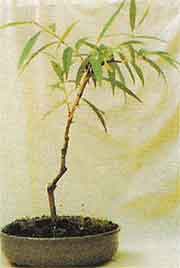
This was one of the very first trees that I trained as a bonsai when my interest in this hobby began. I was aware that willow branches were easy to root and pruned a small branch from a friend's weeping willow one spring, as the buds were beginning to open.
It quickly rooted in a bucket of water and was then potted into a flower pot where it grew well in its first year.
Willow Bonsai History: Training
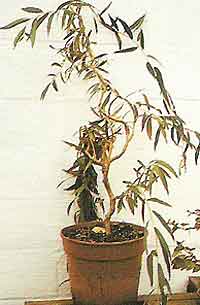
The next spring I planted the willow into a shallow, round bonsai pot. I had no experience or knowledge of how to treat this variety and for the next two years I thoughtlessly pinched the growing tips to stop them becoming long.
After this time I decided that the tree would benefit from being planted in a large flower pot and it responded well to this extra space for root growth. A new leader was wired upwards to increase the height and in the summer I sat the pot with its thirsty tree in a saucer of water.
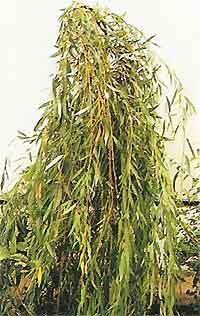
Although the willow had grown well, the trunk was still fairly thin and I had now decided that I wanted a larger tree than I had previously envisaged. In the spring it was planted in a garden border and staked with a cane.
The willow produced an explosion of growth and it was watered well during dry periods. I was conscious that the trunk was lacking taper and utilised a small shoot near the base to grow as a 'sacrifice' branch. The top of the tree was then pruned heavily to direct energy towards this small shoot which quickly began to extend. I also trimmed all of the side branches before they got too thick, to avoid large pruning scars.
After spending less than four years in the ground the willow had reached a height of over 1.8 metres (6 feet) and was beginning to take over the border! The trunk had thickened considerably and the bark was beginning to look older and less smooth at the base.
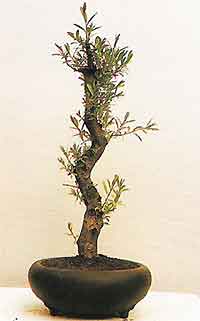
It was time to lift it from the ground and continue its training in a bonsai pot. In the spring the soil was washed away from the roots, uncovering a tangled mass which was pruned heavily. All branches were removed, including the thick sacrifice branch at the back of the tree which had served its purpose, revealing a well-shaped, tapering trunk line.
I planted the tree in a large round bonsai pot and buds quickly emerged all up the trunk. Many were 'rubbed' off and I selected those best positioned to become large branches, allowing them to extend. I fed heavily and stood the pot in a dish of water.
By early summer the growth was long enough to shape and I wired each branch, arching them downwards so that they ended up completely vertical. The shoot tips were pruned to prevent them continuing to grow and spoiling the shape.
From a thick, well-shaped trunk just a few months before, a solid and yet very appealing weeping willow bonsai had appeared.
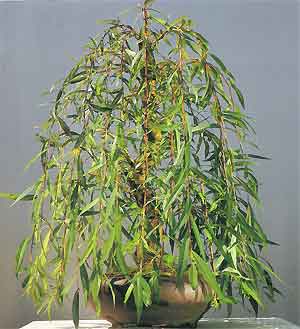
 This was one of the very first trees that I trained as a bonsai when my interest in this hobby began. I was aware that willow branches were easy to root and pruned a small branch from a friend's weeping willow one spring, as the buds were beginning to open.
This was one of the very first trees that I trained as a bonsai when my interest in this hobby began. I was aware that willow branches were easy to root and pruned a small branch from a friend's weeping willow one spring, as the buds were beginning to open. The next spring I planted the willow into a shallow, round bonsai pot. I had no experience or knowledge of how to treat this variety and for the next two years I thoughtlessly pinched the growing tips to stop them becoming long.
The next spring I planted the willow into a shallow, round bonsai pot. I had no experience or knowledge of how to treat this variety and for the next two years I thoughtlessly pinched the growing tips to stop them becoming long. Although the willow had grown well, the trunk was still fairly thin and I had now decided that I wanted a larger tree than I had previously envisaged. In the spring it was planted in a garden border and staked with a cane.
Although the willow had grown well, the trunk was still fairly thin and I had now decided that I wanted a larger tree than I had previously envisaged. In the spring it was planted in a garden border and staked with a cane. It was time to lift it from the ground and continue its training in a bonsai pot. In the spring the soil was washed away from the roots, uncovering a tangled mass which was pruned heavily. All branches were removed, including the thick sacrifice branch at the back of the tree which had served its purpose, revealing a well-shaped, tapering trunk line.
It was time to lift it from the ground and continue its training in a bonsai pot. In the spring the soil was washed away from the roots, uncovering a tangled mass which was pruned heavily. All branches were removed, including the thick sacrifice branch at the back of the tree which had served its purpose, revealing a well-shaped, tapering trunk line.